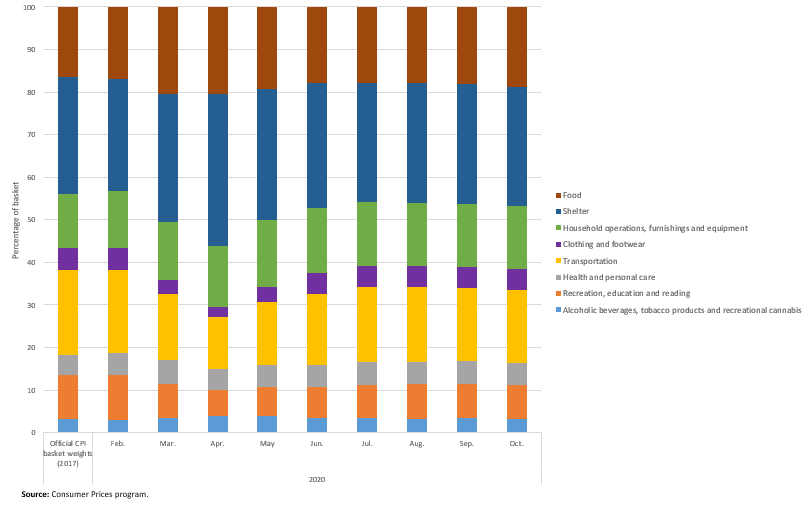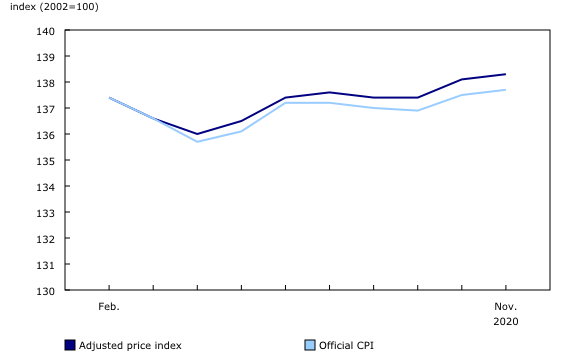Consumer prices: The adjusted price index and basket weights
Archived Content
Information identified as archived is provided for reference, research or recordkeeping purposes. It is not subject to the Government of Canada Web Standards and has not been altered or updated since it was archived. Please "contact us" to request a format other than those available.
Released: 2021-01-12
Canadians have been spending a lot more time and money at home during the COVID-19 pandemic and a lot less on travel and other items. Statistics Canada has adapted to these changes in spending habits by developing the adjusted price index in partnership with the Bank of Canada. The adjusted price index takes into account these sudden shifts in spending patterns when weighing the components that make up the Consumer Price Index (CPI).
Consumer price inflation during the pandemic
The COVID-19 pandemic has led to economic disruptions that have affected financial and labour markets across the globe. Very quickly, Canadians began spending differently as they adapted to staying home, travelling less, and buying more of certain items and less of others. Some businesses reopened over the summer as physical distancing measures were eased, starting with the most essential services. Although some consumer spending patterns began returning to the way they were before the pandemic, many remained altered over the fall period.
Shifts in household purchasing patterns have implications for the basket weights used to measure consumer price inflation. A fixed-basket price index, such as the official Consumer Price Index, can only reflect such changes when basket weights are updated.
In partnership with the Bank of Canada, Statistics Canada obtained temporary access to aggregate data on recent expenditures representing the majority of consumer goods and services. These data reflect the new consumption patterns during the pandemic and were used, along with other available alternative data sources, to derive the monthly adjusted basket weights used to calculate the adjusted price index. This adjusted series provides an alternative estimate of consumer price inflation during the pandemic.
Canadians direct more of their spending to food and less to transportation
In October, the monthly adjusted weights for consumer expenditures remained closely aligned with the 2017 basket weights for most of the major components. As new restrictions were introduced in the fall to limit the impact of the COVID-19 resurgence, the share of consumer spending on food edged up, while consumers allocated less money to transportation and clothing compared with July. The adjusted weight for the recreation, education and reading component remained low in October relative to the official CPI basket weight because a lower share of expenditures were directed to travel services, as the US–Canada border remained closed and restrictions discouraged domestic travel.
The adjusted basket weight for the household operations, furnishings and equipment component remained elevated in October as Canadians dedicated a larger proportion of spending to financial services and other household services. The adjusted weights for household durable goods, including furniture, household appliances, and tools and other household equipment, as well as non-electric kitchen utensils, tableware and cookware, edged up as consumer spending on durable goods rose at a record pace in the third quarter of 2020.
Infographic 1
 CPI) and the adjusted price index, Canada, February 2020 to October 2020" />
CPI) and the adjusted price index, Canada, February 2020 to October 2020" />
Basket weights of major components in the official Consumer Price Index (CPI) and the adjusted price index, Canada, February 2020 to October 2020
 CPI) and the adjusted price index, Canada, February 2020 to October 2020" />
CPI) and the adjusted price index, Canada, February 2020 to October 2020" />
The gap between the adjusted price index and the official CPI widened in September, corresponding with the increase in COVID-19 cases that marked a resurgence of the pandemic. Higher food prices, particularly for meat and vegetables, in October and November became more important in the adjusted price index, contributing to the gap between the adjusted price index and the official CPI. At the same time, transportation prices became less important in the adjusted price index, reflecting reduced air travel and low domestic and international demand for gasoline amid the tightening of public health restrictions.
As a result of the food and transportation components, the adjusted price index remained higher than the official CPI in September, October and November. In November, the adjusted price index rose 1.4% on a year-over-year basis, while the official CPI increased 1.0%.
In November, the air transportation index was the largest contributor to the difference between the one-month changes in the two indexes. While many flights remained cancelled or suspended as a result of the pandemic, airlines continued to offer incentives, including reduced fees, discounts and promotions, to encourage Canadians to resume travelling. These lower prices for air transportation became less important in the adjusted price index.
The change in annual average CPI, which is used by most programs employing the CPI for indexation purposes, measures the change in the annual average of the CPI between 12-month periods. The change in annual average CPI for the 12-month period ending in November 2020, compared with the 12-month period ending in November 2019, was 1.1% for the adjusted price index, compared with 0.9% for the official CPI.
Note to readers
The adjusted price index is experimental and should not be used instead of the official measure of consumer price inflation. The official Consumer Price Index (CPI) is based on a fixed basket that aligns with international best practices. It should be noted that there is no clear indication yet how long consumer expenditure patterns will be affected by the COVID-19 pandemic. Frequent updates to the CPI basket of goods and services to account for consumption changes, in the absence of a robust and detailed source of expenditure data, would compromise the accuracy of the index values.
As the influence of the COVID-19 pandemic on the consumption patterns of Canadian households is ongoing, Statistics Canada continues to examine complementary measures of inflation that reflect price change as experienced by Canadians. The adjusted price index, introduced as a temporary measure at the onset of the pandemic, has proven useful to supplement the official measure of consumer price inflation. Now that the economic effects of the pandemic have endured for some time, Statistics Canada will continue to monitor consumer behaviours and expenditures in preparation for the next CPI basket update, which is currently planned for July 2021.
Products
The analytical papers Consumer expenditures during COVID-19: An exploratory analysis of the effects of changing consumption patterns on consumer price indexes and Adjusting the Consumer Price Index to the new spending realities during the pandemic provide detailed information on the data and methods used to calculate the adjusted price index series, as well as on the adjusted weights reflecting consumer spending. The data table for the adjusted price index now includes data for September, October and November 2020, as well as revised data for prior months. The data table for the monthly adjusted consumer expenditure basket weights now includes data for August, September and October 2020, as well as revised data for prior months.
Contact information
Statistics Canada welcomes feedback on this experimental work. Questions and comments can be directed to statcan.cpddisseminationunit-dpcunitedediffusion.statcan@canada.ca.
For more information, or to enquire about the concepts, methods or data quality of this release, contact us (toll-free 1-800-263-1136; 514-283-8300; STATCAN.infostats-infostats.STATCAN@canada.ca) or Media Relations (613-951-4636; STATCAN.mediahotline-ligneinfomedias.STATCAN@canada.ca).
- Date modified:

